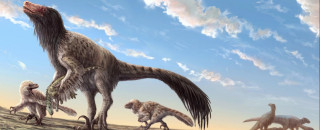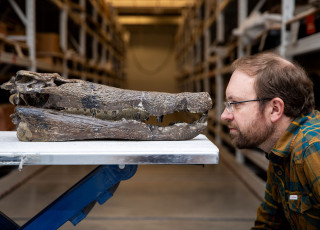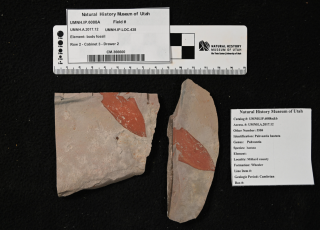Using Skin Impressions and Feathers to Bring Dinosaurs to Life
By Grant Olsen
The theme of this year’s DinoFest on January 28 and 29 is "Bones to Beasts," which will highlight how paleontologists go from excavating bones in the field to reconstructing how dinosaurs looked, grew, and moved. When it comes to reanimating these magnificent beasts from even the smallest collections of fossils, paleoartists play a crucial role.
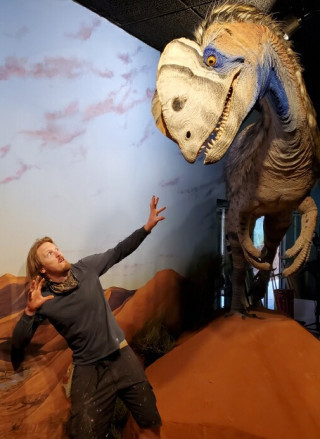
What is a paleoartist? As the name suggests, it's a fusion of 1) the scientific processes of studying evolution through fossils, and 2) the artistic processes of painting and drawing past life based on observations of living animals and other organisms. It's a perfect mix of science and art that drew the interest of Brian Engh, a renowned paleoartist who will be presenting at DinoFest: Bones to Beasts.
“Paleoart has science built into it,” says Engh. “We’re using the art to tell scientific stories, help people appreciate more of what makes nature beautiful, what makes it work, and makes it worthy of study and protection.”
In that work comes a lot of responsibility to represent our understanding of ancient animals as accurately as possible. This requires a strong understanding of current research, anatomy of living animals, and great attention to detail. For example, one of the biggest pieces of scientific evidence that informs paleoart is the up-close detail of fossilized feathers and skin impressions.
You Can Learn a Lot from First Impressions
Beyond fossilized bones, skin impressions and fossilized feathers have been crucial to helping experts understand what dinosaurs looked like. For over a century, the prevailing public image of dinosaurs was that of oversized lizards lumbering around swamps. Their leathery skin was usually depicted in earth tones, making them appear rather bland and unrelatable.
But more recent discoveries of fossilized feathers, with some containing preserved organic residue, have given us bold new perspectives of how dinosaurs looked,including bird-like traits. So rather than the aforementioned oversized reptiles draped in gray leather, many dinosaurs were more nimble creatures with feather-like body coverings.
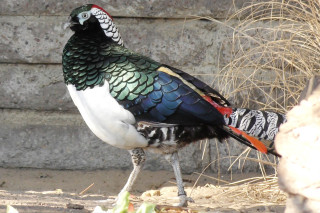
Of course, there were many dinosaurs that indeed had scaly skin. But even these more reptilian creatures have feathered dinosaurs in their family trees, and were likely just as colorful as modern birds.
“Instead of thinking of dinosaurs as scaly reptiles that slowly gained feathers, we should probably be thinking of them as evolving from small, fuzzy animals,” explains Engh. “Some of them lost their feathers or developed a scaly skin covering more of their bodies, while other groups evolved those fuzzy bodies into feathers.”
Just as duck-billed dinosaurs and horned dinosaurs lost their fuzzy covering as they evolved larger body sizes, a similar trend evolved in mammals, where elephants, and rhinos also lost their fur as they got big.
A World of Color
As dinosaurs evolved, their feathery coverings and scaly skin began to look wildly different. Some were camouflaged to blend in with their surroundings, while others may have been as brightly colored as the most ostentatious bird species.

How do we know about the coloration of dinosaurs? Colors are derived from physical structures within skin or feathers, which can sometimes preserve within the fossilized organic residue. And these structures can actually leave a trace in the fossil record, so on a microscopic level we can gain insights into colors through comparisons with modern reptiles or birds.
For example, viewing certain dinosaur feather impressions under a microscope reveals the same structures found in iridescent feathers of modern birds. Birds, along with other living relatives of dinosaurs, also have color vision that was inherited from their predecessors. So forget those drab illustrations of dinosaurs from your elementary school textbooks. It’s almost certain that dinosaurs walked and saw the world in a full spectrum of color.
Bringing It All to Life
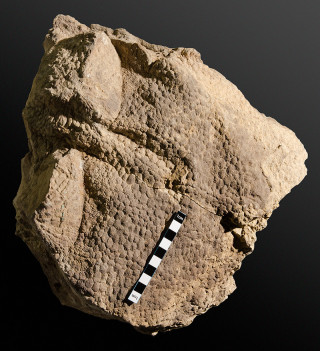
For paleoartists like Engh, clues from the fossil record—such as feather color—are fleshed out with interpretation and creativity. While working on a piece of art depicting a duck-billed dinosaur from the Upper Cretaceous Menefee Formation in New Mexico, Engh used photos from NHMU’s most complete fossil to define the skin texture for his recreation.
“All of these hadrosaurs are covered with a basement of small hexagonal scales, but each species seems to be somewhat uniquely decorated with enlarged tubercle scales and big scales of various shapes running down the midline along their spine,” wrote Engh. “This incredible Gryposaurus fossil on display at the Natural History Museum of Utah has enlarged scale structures along the midline that look really cool, with a heart-shaped footprint, and ridges that remind me of the erosional channels running down the sides of mountains or badlands.”
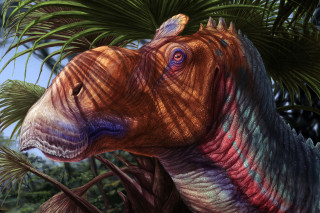
Other insights and inspiration came from natural features such as gecko eyes, duck bills, and crocodile noses. When put together, Engh was able to deliver a scientifically informed artistic work that is used for a popular exhibit at the Western Science Center in Hemet, California.
You can learn more about Engh’s approach to paleoart by attending his talk at this year’s DinoFest. View the DinoFest schedule and learn more here.
